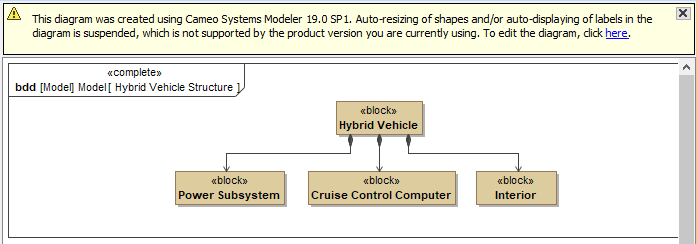The cross-version compatibility checking mechanism is triggered when a project with new feature usages is loaded with an older version of the modeling tool. The mechanism tracks feature usages of 19.0 SP1, 19.0 SP2, 19.0 SP3, and later service pack (SP) versions that result in the appearance of a Missing features detected notification in earlier modeling tool versions. The following table shows tracked features, the version they appear in, and whether the project can be committed/saved without any consequences.
| Feature name | Version | Secure to commit/save |
|---|---|---|
| 19.0 SP1 | No | |
| 19.0 SP1 | No | |
| 19.0 SP1 | No | |
| 19.0 SP2 | Yes | |
| 19.0 SP2 | Yes | |
| Contextual relationships in the dependency matrix | 19.0 SP3 | Yes |
| Displaying classifiers on internal structure and behavior diagrams | 19.0 SP3 | Yes |
| Custom hierarchy in tables | 19.0 SP3 | Yes |
| Lock-free Model Editing | 19.0 SP3 | No |
If you are working with features that can cause inconsistencies after save/commit (see the table above), the following warning message indicating possible consequences if you proceed will be shown.
Diagramming features
Forward compatibility tracks the following diagramming features introduced in 19.0 SP1:
When opening a project with a tool version 19.0, the usage of these features makes the diagram read-only. Additionally, you will be warned of possible consequences if you edit the diagram:
This mechanism prevents unexpected changes after opening a project with a version 19.0 SP1.
Compatibility of profiles
While the tool is backward compatible, we highly recommend for every user working on a particular project to use the same version of the tool. For example, if you use an older version of the tool and open a project created with a later version, a balloon notification pops up:
To avoid this:
- Make sure that every user working on the same project uses the same version of the tool.
- Do not migrate profiles unless every user working on the same project is informed and ready for migration.


